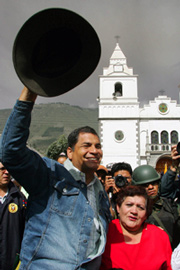Ecuador volcano forces evacuations
At least 1,450 people resettled in nearby towns after the Throat of Fire erupts.

He said the entire region surrounding the volcano – comprising 10 towns and villages with some 20,000 residents – remained under a red alert, with all schools closed until further notice.
Presidential visit
Rafael Correa, the Ecuadoran president, visited some of the affected villages on Wednesday, after putting the region under a state of emergency in order to release federal funds and assistance programmes.
“Together we will fight against nature if necessary, and we will defeat it,” Correa told hundreds of evacuees near the slopes of the volcano.
 |
| Correa presented temporary housing units in Penipe [AFP] |
Correa presented 185 temporary housing units to displaced villagers in Penipe, a town near to Tungurahua.
Transito Gavilanez, a 70-year-old Ecuadorean farmer living in and out of shelters since Tungurahua began its eruption cycle nine years ago, praised Correa for his assistance.
“Thank you Mr President for a new home,” he said.
Juan Salazar, the mayor of Penipe, said: “The goal is for these families to regain what the volcano has taken from them. We want to give them housing and land.”
Ecuador has tried to implement a programme to resettle hundreds of poor farmers who live on the shadow of Tungurahua.
But many of the peasants defy the roaring volcano and climb back to their mud-home hamlets to harvest their crops and livestock.
No injuries
The eruption of Tungurahua so far has caused no injuries or damage, outside of the tons of ash deposited on buildings, agriculture and roads in the region.
The volcano, 135 km south of Quito, the capital, has been active since January, with up to 30 explosions, earthquakes or rumblings per hour.
The latest eruption is similar in size to the August 2006 eruption, which killed six people, and buried several communities under ash and left 6,500 people homeless, a regional geophysical institute said.
Another eruption in 1999 forced all 15,000 residents of Banos to abandon their town for several months.